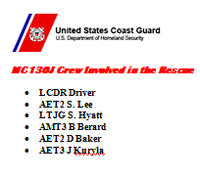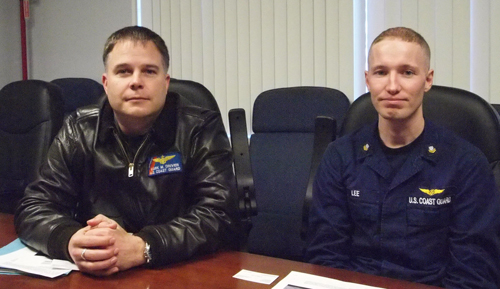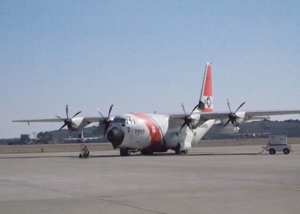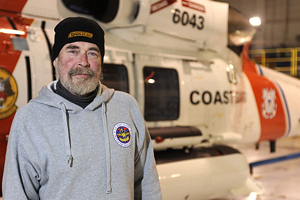“Reverse Engineering” of USCG Operations: the Hatteras Rescue (Miracle) Case
Early January 2010, a dramatic rescue effected by the USCG was done in cooperation with the US Navy to save a man’s life at sea. This rescue involved key C4ISR assets on the new USCG MC-130Js. In a time of budgetary crisis, the USCG is still in dire need for new assets as its old ones are retired because they are just too old to operate. The new ones provide significant enhancements for operations as well. Too often when a service asks for a new asset, the need seems unclear or the impact of the new over the old is also unclear. We intend on this website to “reverse engineer” some USCG operations to provide readers with a better understanding of how the USCG achieves success, what training, manpower and assets are required to do so. We will also highlight when relevant the impact of new systems in achieving that success as well.
The impact of modernization on operations could not be clearer than in this case of rescuing a sailor at sea. Not only did the new mission systems and C4ISR assets play a central role in allowing the USCG professionals to save this man’s life, it would have been unlikely that either the effort or the joint team communication involved in the effort would have been possible.
Here the redundancy of the new mission systems allowed the crew to operate in extremely challenging conditions. The systems allowed them to locate the man miles before they would have been able to with the old systems; time was of the essence and the new systems allowed that time. And when the MC130J became mission critical with regard to fuel, they were able to hand off through the C4ISR systems, the data that they had generated to the replacement MC130J. This allowed for continuity at a crucial moment.
Lt Commander Lacer Driver and his mission systems officer, AET2 S. Lee, explained to us in an interview on February 16, 2010 at the Elizabeth City USCG Air Station how they conducted the operation. Without the tools available on the MC130J they would not have succeeded; without their skill, rapid decision-making process and professionalism under duress, no amount of equipment would have mattered. Crews (men and women) and the equipment are essential to this type of success.
SLD: Why don’t you explain the mission on January 3rd and the challenging kind of rescue you had to do and how that operation was conducted?
Lt. CDR Driver: Yes sir: we were the search and rescue team that night for the C130J community, stationed at Elizabeth City. We had come on duty that morning at 7:45, we flew an afternoon training flight a little over 2 hours in duration, wrapped that up and we were all just calmly waiting to see if anything else would happen.
Shortly after 17:00 local time, just as the sun was setting, a call came in that a sailing vessel’s EPIRB (Emergency Position Indicating Radio Deacon) signal had been detected approximately 280 miles east of Hatteras from the Outer Banks. We were told to launch to go out to see if we could find the source of that EPIRB. We did a quick weather check and weather at home station here was very benign, however we knew that a large low pressure system had moved off shore, I checked the weather and still conditions looked to be fairly manageable with winds peak gusts at 30 knots.
We quickly got airborne on our C130J and immediately upon going feet wet, I asked my MSO here to bring up our DF430 direction finding capability, and approximately 70 miles off shore or so, we began to get our first bearing point to the source of the EPIRB .This is a significant improvement from my previous experiences in the C130H community, which does not have the advanced systems we do on the C130J. Normally we would have to get much closer to a source, the beacon source in order to get any kind of a hit or composite.
SLD: And you just said you were 70 miles?
Lt. CDR Driver: We had a solid block at 70 miles off shore.
SLD: With the C130H systems how close would you have needed to be?
Lt. CDR Driver: With the H we would have to have gotten much, much closer in order to get any sort of a point at all on the EPIRB signal. I climbed to an altitude, I believe we were up at 230, we had 150 knots of wind on the tail, wind and weather conditions were more severe than forecasted, and as we descended into the area, very close now to the source of the beacon, it was evident that the weather was going to be a lot worse. Winds were sustained at 60 knots on the surface, seas were at 30-40 feet, the ceiling was solid overcast between about 800-900 feet above the water, all the way up to around 12,000-13,000 feet, solid overcast with heavy convective activity of snow squalls, we had icing conditions, sustained moderate turbulence with some severe turbulence and we knew we were going to have our hands full.
We had one disadvantage that night, that one, what some people would consider key part of our C4SR system, which was the MMR or multi mode radar, was not functioning. But the depth of the C4SR systems on the airplane made the difference. Under optimal circumstances, we would have had that MMR working, and I probably could have found that sailing vessel even though it bobbed on 30-40 foot seas, I probably could have found it that way, but that system was down.
We used the 241 nose mounted weather radar to help us avoid the worst convective activity, weather conditions that could’ve really damaged the aircraft and been pretty bad for our health and safety. We were able to use that weather radar for that purpose, but we didn’t have an MMR to help us find the target sailboat.
The good news is, Petty Officer Lee, our MSO was able to take the DF430 equipment, was able to choose lines of bearing on a easterly, westerly heading and on a north-south heading, and we were able to triangulate the source, the signal of that sailing vessel without actually finding it on our radar. So the DF430 paid huge dividends in not only acquiring the signal early, but once we got out there, it helped us pinpoint that location even though we didn’t have the benefit of our marine radar.
We found the sailing vessel, got over top of it and were able to immediately establish communications with the captain of the vessel, using his VHF-FM, VH-FM band radio channel 16, and we discovered the dire circumstances: this gentleman had been at sea for 5 days at that point, he’d gotten into terrible weather 3 days earlier, he experienced numerous knock downs, the vessel was basically de-masted, his motor was inoperative, he had a prop that was fouled and was essentially dead in the water and could not control his vessel, was getting beamed to the seas and the boat was coming apart underneath of him.
We were able to pinpoint his location with the DF430 and then other C4ISR systems like for instance the night vision goggles we wore that night, were absolutely invaluable and critical. The pilots and crew in the back wore NVG’s throughout the duration of the mission, we were able – below that overcast, solid overcast layer – to see the vessel.
When the gentleman would key his radio, his VH-FM radio and a small light would come on his radio, we could actually see that in the darkness, and we used technique where we just had him take a little hand held penlight, he happened to have a little survival pen flashlight, and he could use that to signal his location.
And in those kinds of difficult weather conditions, it was critical using those NVG’s to keep our eyes on the target. We also greatly employed our FLIR (Forward Looking Infrared Radar), the FLIR turret, the FLIR ball and camera that night, our MSO was able to keep the FLIR on the target, in fact that system is what provided this picture that you have on the website, and we could maintain much better awareness of the status of the mariner, it was very dark and with the NVG’s, we could find the vessel’s location, but we couldn’t see the fine detail of what he was doing on deck. The FLIR allowed us to know that he was actually still on deck; we didn’t need radio transmissions or we didn’t need to demand that he use his radio and potentially run down the batteries on his radio. We could see him active on his sailing vessel and we knew that he was still safe and on board. So that helped prevent unnecessary radio communication.
We were also able to determine which direction he was steering, to determine the wind and where to actually do our drops. The vessel’s aspect is very critical during these drop evolutions, that eventually we’ve found ourselves performing.
And to be able to know where port and starboard was for this captain in relation to our position and sky and the three dimensional world, it was really very helpful because we could literally say to him, turn right, look right off your starboard bow and take a look over here, you will see the airplane coming at you, and he was able to do that and we were able to correlate that in space and time using the FLIR and the aspect ratio that we got from the FLIR.
Petty Officer Lee (Missions Systems Officer): I was able to get a couple flares off of that too once we started pointing in the right direction; we talked to him on the 16, and he was able to pop off a couple flares for us.
Lt. CDR Driver: We had night vision capability both in the NVG’s that we wore on our heads: because those NVG systems were fully integrated into the cockpit design and layout of our instrumentation, there was no conflict between those systems. Also the night vision capability we had in the FLIR as I just demonstrated was pretty critical that night.
From a communications standpoint, we relied heavily on really at least 3 radio systems:
- some were very basic: the VH-FM capability talking on channel 16 with the mariner was important
- we also were able to utilize our Inmarsat radio, which we call the Steve phone
- and Inmarsat communications, that allowed us to call back to Elizabeth City and talk directly to our watch center here and coordinate the follow-on assets, the launch of an additional C130J, as well as coordinate the launch of the H60, that eventually came off the USS Eisenhower and affected the hoist.
We were able to coordinate these things through that capability and that was critical. The organic HF baseline radios were critical in maintaining our radio guard and talking to RCC (Rescue Coordination Center) Norfolk and getting our tasking and keeping our chain of command informed of what was happening out there on scene. And so those communications were all pretty critical.
So you can see that even though one piece of our C4ISR system, the MMR had failed, we were able to fall back on the other redundant systems and fill that gap and perform the mission.
To make a long story short, we stayed over this gentleman for approximately 4 hours, the vessel continued to get heavily damaged in the seas, and with about 30 minutes left prior to having the H60 from the Eisenhower on scene, we became fuel critical. Just as that was all coming to the head, the vessel was hit by a massive 40-foot wave which caused it to roll 360 degrees. The mariner, the captain on board was tethered with a safety line to his vessel and he managed to stay with the vessel during that complete roll, when he came back up he was extremely agitated, as you can imagine, and basically said he did not think he was going to be able to last much longer.
Because I was fuel critical, and I had reserved the rescue rafts and the rescue gear in the back for when I needed them, I quickly realized that time was now to launch them. So with the remaining fuel I had on scene, we relied heavily on the computer systems on board the HC130J to set up a rudimentary drop pattern for us. What we quickly discovered was that because the winds were so strong at 60 knots sustained with occasionally higher gusts, the computer calculated drop solutions that actually became unusable.
If you will, the course that I needed to fly was perpendicular to the wind line; the purpose being we would drop the three rafts into the ocean and the wind would cause the rafts to drift down onto the mariner and his sailing vessel. Because we were perpendicular to the wind, it required at least 45 degrees of correction in order to keep the plane flying on its required course to make the drop; I had to move 45 degrees.
My heads up display and the entire computer calculated drop data were unusable to me, so I ended up having to revert to a visual only drop maneuver. Again, the NVG’s made that possible, without them I could not have successfully done that, and we were able to perform the drop, push the 3 rafts out just as we were fuel critical, we began to climb to altitude and just before we had to depart we witnessed the rafts drifting down on the position of the sailing vessel.
We communicated two more times with the captain before his radio completely failed. The water intrusion from that roll finally caused his radio to fail, we lost all communications, but we left our final instructions with him in the blind and began to climb out to altitude.
As we were climbing out, the C130J #2 was coming straight in and we passed in flight as he arrived on scene, and I was able to use the on board communication system to pass all the pertinent mission data to the 2nd C130J that was relieving us on scene. And we basically battled those same 150-mile an hour winds back to Elizabeth City and landed with a marginal amount of fuel.
We didn’t know the rest of the story until the next day. We found out that just after climbing out and doing a handover with both the C130J that was arriving on scene and the H60 that was now only about 20 minutes out, from the USS Eisenhower, we discovered that just after we left a second 40 foot wave hit the sailing vessel. This wave completely rolled the vessel again; throwing the master off, his safety line broke so he was a person in the water at that point. He said just as he struggled to the surface to get his first breath, he looked and very close to him he saw his sailing vessel break apart and sink.
So just after we left, he went in the water, he made the statement that he really got a breath, he realized his situation was dire, he made peace with God, but he wasn’t ready to give up yet. And he said he got a few breaths, he allowed himself just a little bit of rest from the exhaustion that he was suffering, and he began to swim.
Miraculously he said he only took a few strokes swimming and bumped into an unlit object he could not see, it turned out to be the rescue raft, one of the three rescue rafts that we had dropped to him.
The raft had been blown upside down in the swells and the sea state, so he did not see the chem. light and strobe that we had attached to it, but he was able to right the raft and climbed into the raft 300 miles offshore, and probably only 15 minutes later the helicopter arrived on scene, saw him in the raft and was able to hoist him to safety out of the raft that we had dropped.
———-
*** Posted on March 9th, 2010






